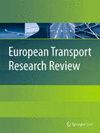Assessing potential sustainability benefits of micromobility: a new data driven approach
IF 4.2
3区 工程技术
Q1 TRANSPORTATION
引用次数: 0
Abstract
Promoting the shift from private cars to micromobility (e.g., bike, e-bike, scooter) can represent a valuable action to improve city sustainability and liveability. Micromobility can help to replace trips by individual private cars (e.g., daily short round trips) as well as to improve coverage and accessibility of transit services, and, subsequently, to reduce the traffic impacts (e.g., pollutant emissions). It can be seen as a potential solution to move people more efficiently in urban areas, as well as to push people towards a more active mobility behaviour, contributing to the well-being goals. In this context, the paper, rather than inferring the users’ propensity to change their travel mode, proposes a methodology to identify car trips that can be considered the most compatible with micromobility. Estimation of the potential demand (e.g., the upper level of car trips that could be replaced by micromobility) is carried out by exploiting the opportunity offered by floating car data (FCD) for characterising car trips. Its goodness is therefore evaluated through an application to a real case study (i.e., the city of Trani, Apulia Region, Southern Italy), divided into seventy traffic zones, and where a FCD dataset of about 5,200 trips was available. The FCD allowed the car trips to be characterised (e.g., origin and destination, path features) instead of using the traditional surveys. The results indicate that a significant share of daily car trips can be substituted (i.e., the most compatible) by micromobility (31% of car round trips in the case study), with considerable potential environmental gains (traffic emission reduction; less than 21% of total emissions from private cars). Results can be of interest to local authorities in integrating micromobility in urban mobility planning and promoting new sustainable transport alternatives, as well as to transport companies for designing new appeal services. The developed methodology is parametric and uses easy-to-obtain data available worldwide; thus, it can be easily transferred to other city contexts.评估微型交通的潜在可持续性效益:一种新的数据驱动方法
促进从私家车到微型交通工具(如自行车、电动自行车、滑板车)的转变,是改善城市可持续性和宜居性的重要行动。微型交通有助于取代个人私家车出行(如日常短途往返),提高公交服务的覆盖面和便利性,从而减少对交通的影响(如污染物排放)。这可以被视为一种潜在的解决方案,既能更有效地运送城市地区的人口,又能推动人们采取更积极的交通行为,从而为实现福祉目标做出贡献。在这种情况下,本文不是推断用户改变出行方式的倾向,而是提出了一种方法,以确定哪些汽车出行最符合微移动性。通过利用浮动汽车数据(FCD)提供的机会来描述汽车出行特征,从而估算出潜在需求(例如,可被微交通取代的汽车出行上限)。因此,通过对一个实际案例研究(即意大利南部阿普利亚大区的特拉尼市)的应用,对其优越性进行了评估,该案例研究分为 70 个交通区,并有一个包含约 5200 次出行的浮动汽车数据集。利用 FCD 数据集,可以对汽车出行进行特征描述(如出发地和目的地、路径特征),而不是使用传统的调查方法。结果表明,微型交通可以替代(即最兼容)相当大比例的日常汽车出行(案例研究中汽车往返出行的 31%),并具有相当大的潜在环境收益(减少交通排放;不到私家车排放总量的 21%)。研究结果有助于地方政府将微型交通系统纳入城市交通规划,推广新的可持续交通替代方案,也有助于运输公司设计新的吸引力服务。所开发的方法是参数化的,使用的数据在全球范围内都很容易获得,因此可以很容易地应用到其他城市。
本文章由计算机程序翻译,如有差异,请以英文原文为准。
求助全文
约1分钟内获得全文
求助全文
来源期刊

European Transport Research Review
Engineering-Mechanical Engineering
CiteScore
8.60
自引率
4.70%
发文量
49
审稿时长
13 weeks
期刊介绍:
European Transport Research Review (ETRR) is a peer-reviewed open access journal publishing original high-quality scholarly research and developments in areas related to transportation science, technologies, policy and practice. Established in 2008 by the European Conference of Transport Research Institutes (ECTRI), the Journal provides researchers and practitioners around the world with an authoritative forum for the dissemination and critical discussion of new ideas and methodologies that originate in, or are of special interest to, the European transport research community. The journal is unique in its field, as it covers all modes of transport and addresses both the engineering and the social science perspective, offering a truly multidisciplinary platform for researchers, practitioners, engineers and policymakers. ETRR is aimed at a readership including researchers, practitioners in the design and operation of transportation systems, and policymakers at the international, national, regional and local levels.
 求助内容:
求助内容: 应助结果提醒方式:
应助结果提醒方式:


